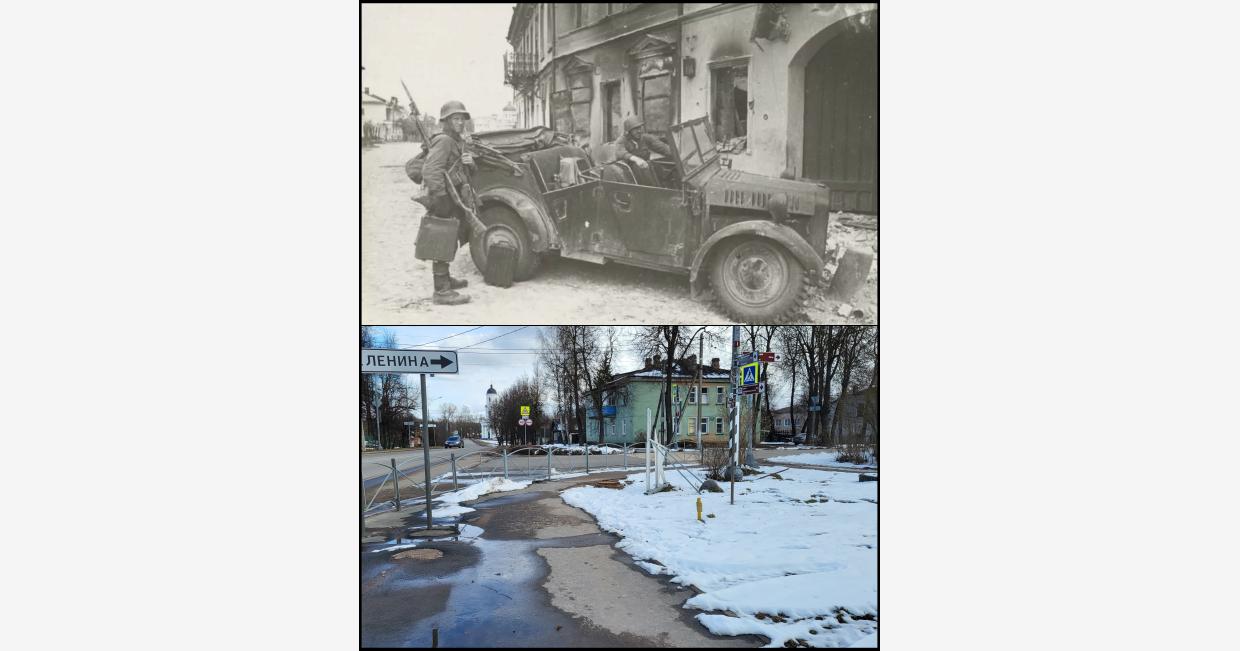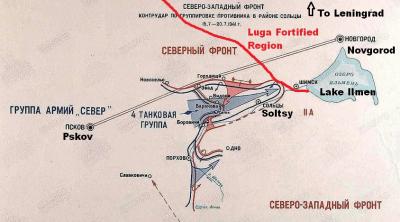Soltsy, intersection of Sovetsky prospekt and Lenin street. 16.07.1941-02.04.2023
Soviet soldiers examine abandoned German officers' car in Soltsy.
This location was quite hard to find as the corner building was razed to the ground by the retreating Germans in February 1944. The only visible reference point is the colonnade of the belltower of Ilyinskaya church, barely discernible in the background. The belltower itself was demolished in the 1930s and reconstructed in the 2000s.
After the capture of Pskov on July 9, 1941 General Manstein decided to take a significant risk by making a daring forward thrust with his mobile forces. Without waiting for the slow infantry units to catch up, he aimed to make a breach in the hastily built major Soviet defensive line — the Luga Fortified Region. One of the few successful and well-timed decisions of the leadership of the Soviet Northern Front, it was ordered to be built already on the second day of the war. Several hundred thousand civilians, including many women and teenagers from Leningrad took part in its construction. A 250-km line of bunkers, trenches, minefields, anti-tank ditches and other defenses was built in only 2 weeks. Far from being anything close to the Siefried or Maginot line, it was still a serious obstacle for the overstretched German force, and since the Barbarossa offensive had to be conducted on a very tight schedule, even a few days of delay were seen as a highly undesirable development. By rapidly thrusting his tanks through these underbuilt and undermanned defenses, Manstein hoped to capture Novgorod on the fly, opening himself an undefended road to Leningrad and outflanking heavy Soviet defenses around the town of Luga. Had he succeeded at that, the fall of Leningrad would have become imminent.
In these very days, Marshal Voroshilov, who was placed by Stalin to supervise both the Northern and the Northwestern Fronts, ordered to urgently send 3 divisions, including the 21st Tank Division with a large number of KV-1 tanks, in order to reinforce Soviet defences at the approaches to Novgorod. Having received intelligence reports on the overstretched 8th Panzer Division, which spread its units thin across the highway that ran along the river Shelon for more than 50 kilometers, he ordered to immediately throw these reserves into action and encircle the Germans.
The offensive began on July 14th, 1941 and on the very first day the Germans were pressed hard all along the highway, which fell under heavy fire of Soviet artillery. Although the Red Army wasn't able to cut the 8th Panzer Divison off completely, it was forced to run the gauntlet of fire, retreating more than 35 kilometers to the west. The town of Soltsy was liberated for only 4 days before the Germans took it back, but the precious time to strike at unprepared defenses was lost, and Manstein's hubris cost him several dozen tanks and hoards of other equipment including motorcycles, trucks, AT guns and several Nebelwerfers. To add insult to the injury, one of these rocket launchers was abandoned along with a top secret chemical ordnance handling manual, which was immediately reported by the Soviet press and created a diplomatic row as the Germans had to explain whether they wanted to use poison gas on the battlefield.
The Soviet writer Alexander Rozen, who served in the 70th Rifle Division which took a major part in this operation, wrote the following words about these events: "Ah, what a great joy it was to see fleeing Germans in July 1941! In the worst days of the Siege of Leningrad we remembered that we weren't scared of the Germans on the banks of Shelon and held them for an entire month at the distant approaches to Leningrad... In the darkest days, when it seemed that death would definitely seize us in its grip, we said to ourselves: "Soltsy!" And this carried us through. We did it. And this meant - we'll persevere!"

